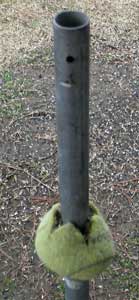How to Make a Conical (Zeleny) Baffle / Predator Guard
Predator guards on posts are essential to protect eggs, nestlings and incubating parents from climbing predators. To be effective against raccoons, a conical baffle (also called a Jensen-Arndt or “coolie hat” coon guard) needs to be at least 3 feet in diameter. Note that even this size does not deter large snakes (over five feet long) well. Conical baffles may be harder to make, more expensive, and less effective than a stovepipe baffle, and sharp edges can be a problem around children and during monitoring. Some raccoons learn to get around them. However, they are probably the easiest baffle to put up when a nestbox is mounted on a wooden post.
Materials: (note: tractor disc blades also work well, and can be found at farm auctions.)

- 24 or 26 gauge galvanized sheet metal (which won’t rust), 3 feet x 3 feet (can also be made with sturdy hardware cloth, but beware sharp edges)
- 3 wooden mounting blocks, 4″ x 1.5″ x 1.5″. You can also cut tabs that bend over and use them to fasten the cone to the post.
- 1/4″ round head stove bolts or small, pan-head sheet metal screws
- Tin snips
- Hardened drill bits (for holes)
- Paint (if desired, to cut down on heat reflectivity and for aesthetics.
Instructions: (also see alternative installation below.)
- Cut a 3 foot square piece of 24 or 26 gauge galvanized sheet metal. (You can get three guards out of a 3×8 foot piece of metal – see drawing below from Zeleny’s book.)
- Then cut out circles.
- Your circle will be 18″ from the center of the circle to the edge (i.e., 36″ in diameter when flat – when formed into a cone the finished diameter will be less).
- You can make a homemade compass to scribe the metal, using a stick of wood with two sharp nails placed 18″ part, or a piece of string and a magic marker.
- To form a cone, you will need an open triangle that measures 9″ on the bottom.
-

Tennis ball set up. See more photos. To facilitate cutting, follow the numbering sequence. To make the first cut (A-B line) make a slot at A with a cold chisel to insert metal shears.
- You can either attach the cone to the post using angled wooden blocks (see Step 6) or metal tabs from the center hole that bend over and are nailed to the pole. Make the tabs about 1.5″ wide, and bend them up to nail to pole/box. The blocks might be better as they will make the baffle wobbly, which is harder to climb.
- Include a hole (with tabs if desired) in the center that will be big enough for your post:
- 5″ hole fits 4″ diameter post
- 6″ hole fits 5″ diameter post
- 7″ hole fits 5.5 – 6.5″ diameter post
- 7.25″ hole fits 6″ diameter post
- If you have a metal/T-post, or small wood post, you can make a V cut instead in the center with three small tabs that can be used to attach the cone the bottom of a 2×4 on the back of the nestbox.
- If you don’t make pre-cut metal tabs you can make angled wood blocks to nail the guard in place. The ends should be angled to fit flush against the post. Drill pilot holes through the nailing block to the post.
- When installing the guard, overlap the cut edge to the dotted line in the drawing below.
- Join the ends with two to four 1/4″ round head stove bolts or use four small, pan-head sheet metal screws to hold it together.
- Paint if desired.
LBBS Alternative Installation Instructions (easier – does not require tab or wood block. Can also be used on T-posts.) SEE PHOTOS. Cone guards CAN be defeated by some long snakes. Watch this photos of a Yellow-bellied Water Snake in a Wood Duck box outfitted with a 30″ cone guard.
- Attach a non-flimsy conduit hanger iron/bracket to the pole. Tighten.
- Cut a tennis ball in half. Cut an X in the center of the top half. (You can find leftovers at tennis courts)
- Slide the tennis ball over the pole to rest on the bracket.
- Slide the cone down to rest on the tennis ball and bracket. The tennis ball fills any holes or gaps that would allow small snake or mouse to come up the pole trying to reach the box.

More Information:
-
-
- Predator and Problem ID and Solutions (guide)
- Comparing Pros and Cons of Various Predator Guard Styles
- Wobbling Stovepipe and PVC baffle instructions
- The problems associated with mounting boxes on trees
- How to make a Noel Guard
- How to make a Hutchings PVC “coon” guard
- Predator and Problem ID and solutions
-
Sources:
-
-
- Bluebird: How You Can Help Its Fight for Survival
- Bluebirds (Camp & Cottage Collection, 2. Wildlife)
- Bluebirds Forever
- The Bluebird Monitor’s Guide to Bluebirds and Other Small Cavity Nesters
- Bluebird: How You Can Help Its Fight for Survival
-

There are so many ways to burn time. The glorious way to spend it is to add plants and wildlife that will have ripple effects far beyond our lives.
– Ron Baltrunas, 2005
